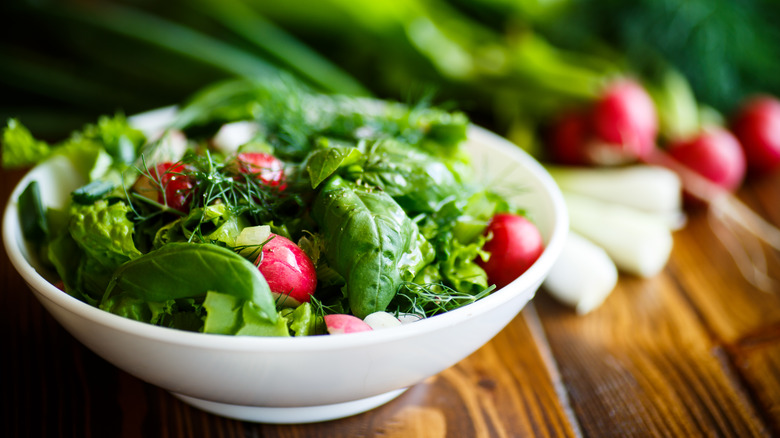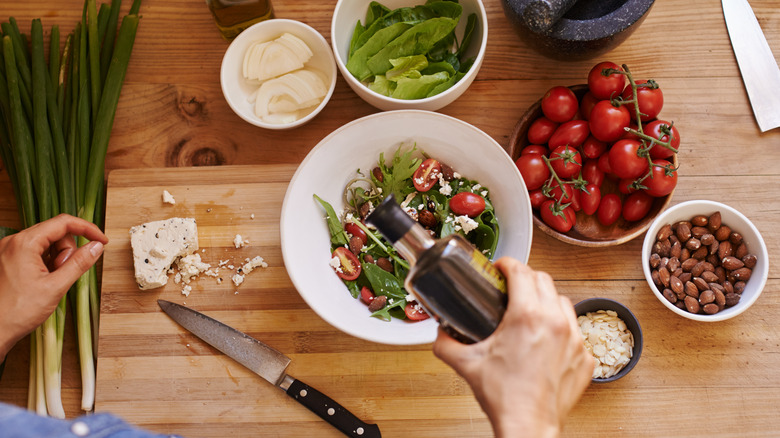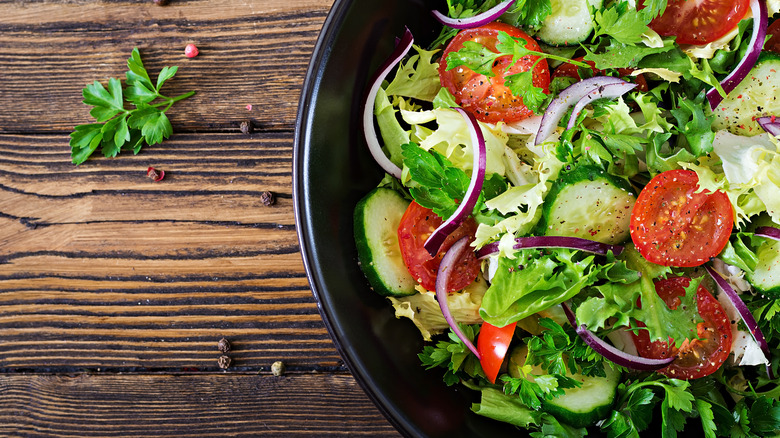The Simple Science For Avoiding A Sad, Soggy Salad
Can you imagine a more unfortunate scenario, than preparing a wonderful, crisp salad, only to serve and find it has melted into a green soggy mess? Everyone has a sad salad story. It can deteriorate so quickly, in shape and color, that you may even ask, how long can a salad stay out before you shouldn't eat it? Well, there is a simple science-based solution that can help your salad to avoid meeting a miserable leafy fate.
Your salad dressing could actually be the reason your salad is passing away. It's hotly debated whether you should toss your salad in oil or vinegar first, as this can affect how long your leaves will stay crisp. Perhaps you're considering using a more nutritional oil in your dressing, but those wilted leaves will persist. The answer to an extended perky salad is using an emulsifier in your dressing — and this is because of how the dressing reacts to the cuticle layer of the leaf.
All about your dressing
A dressing of oil and vinegar alone is doomed to make a wilted, unsatisfying salad. As the two struggle to bond, you can be left with a dressing where the oil will cling to the leaves and the vinegar will get friendly with the bottom of the bowl. This is because salad leaves have a protective oily cuticle layer that reacts differently to different substances.
With vinegar (or other water-based liquids), the leaves prevent absorption and keep crisp. A protective mechanism for when it's raining in the wild. However, with the oil, salad leaves begin to absorb the similar oily consistency and their shape and color diminish.
Using a dressing from just vinegar is out of the question, as it would make an extremely sharp-tasting salad. The answer is using an emulsifier. Emulsifiers like honey, mayonnaise, tomato paste, or even smashed avocado bring the elements of oil and vinegar together. The emulsion allows the oil to remain suspended with the vinegar on the exterior of the leaf — no absorption means crispy salad leaves for longer and you have a guaranteed balance of flavors too.
Other crispy tips
If your salad leaves or herbs are looking sad from the get-go, then you can always use an ice bath as a method of revival. The icy shock will bring them back to their prime — just make sure you pat off any extra moisture before adding them to your salad bowl. Other tips for keeping your salad at its crispy best can include using a mixture of ingredients with different moisture contents. By downgrading the number of watery additions to your salad (like tomatoes), you can ensure your salad leaves remain crinkly and crunchy, not squished in the bottom of the bowl.
It's also important to hold the salt until you're ready to serve. This is osmosis at work, where the salt has the ability to draw out moisture from other vegetables or leaves in your salad, altering their texture from crunchy to flimsy. Lastly, remember to always let hot ingredients cool before adding them to your delicate leaves. Although this seems obvious, remember not to skip this step. Science doesn't have to be complicated, as we've just demonstrated how easy it can be to find the reasons behind your soggy salad bowl.


